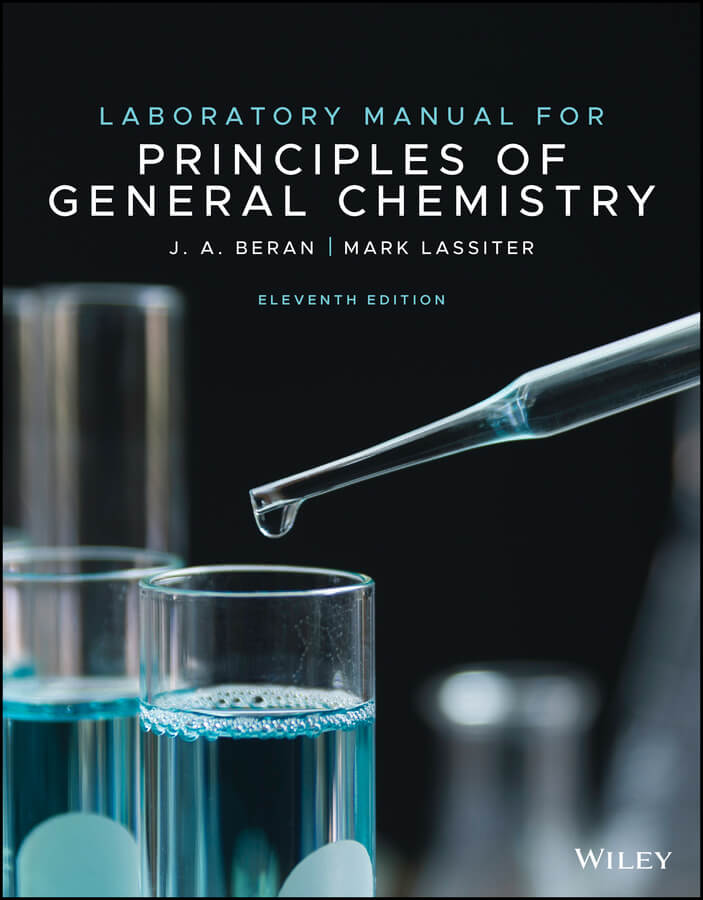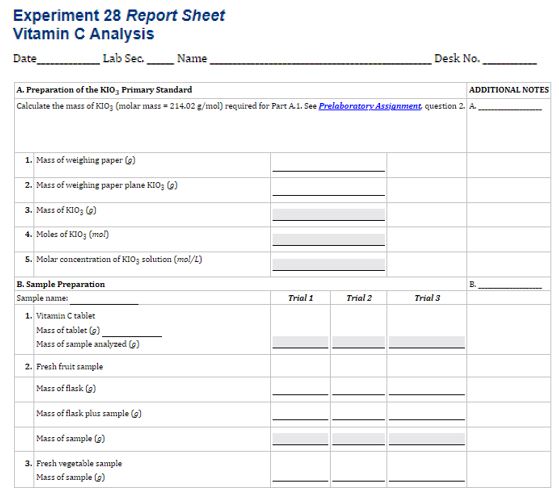
Laboratory Manual for Principles of General Chemistry, 11e
By J.A. Beran, Mark Lassiter
Laboratory Manual for Principles of General Chemistry 11e is available in WileyPLUS with the e-Text and covers two semesters of a general chemistry lab program. The material in the lab manual focuses on lab experiments that demonstrate and showcase the necessity of appropriate experimental procedures, tools, and techniques. Students are able to analyze and interpret data while minimizing the inherent variables associated with the experiment. Students will learn how to make scientific and analytical conclusions based on the data they collected – even if the data isn’t always “right”!
In a lab, students gain scientific literacy when their lab experiences and observations directly connect with the scientific methods they are learning. The lab manual provides structured experiments and dry labs that connect directly to course objectives and provide expanded learning opportunities beyond the experiment for further scientific discovery.
The lab experiments in this lab manual can be paired with any general chemistry textbook, and the 39+ experiments ensure a wide range of topic coverage. The lab manual and WileyPLUS course can be customized to fit the needs of any chemistry lab.
With the 11th edition of the lab manual, the authors bring decades of experience and fine tuning to ensure each experiment is intuitive, informative, and challenging. The experiments offer a solid foundation for technique, safety, and experimental procedure. The addition of WileyPLUS for the first time brings the lab manual to today’s students!
Schedule a Demo Request Instructor AccountWant to learn more about WileyPLUS? Click Here
Lab Technique Videos
Short videos showcasing common fundamental lab techniques used in general chemistry. These videos are directly connected to the techniques used for each experiment in the lab manual.
Interactive Periodic Table
Clickable periodic table that allows students to explore and interact with different elements and properties.
Gradable Pre-Lab and Post-Lab Assignments
Pre-laboratory and post-laboratory assignments are gradable in WileyPLUS for the first time. Instructors can assign assignments before and after the lab to ensure students are completing the necessary pre- and post-work for each lab. The questions are designed to prepare students for their time in the lab and to facilitate the analysis and understanding of the lab they completed.

Report Sheets
Available as a file-upload question, students can download a PDF file of the report sheet with entry fields ready to be completed on a digital device (or printed before the lab). The student will fill out the sheet and re-upload for submission. The digital format allows instructors to track when students complete and submit their lab report sheets, and can work in labs with or without technology. The 11th edition update includes “additional notes” columns in the report sheets to allow for recording data and observations.
*Report sheet templates are available for instructors in Excel when grading. These include the relevant mathematical formulas required for accurate data.*
New to this Edition
Here’s what’s included :
-
-
- Updated lab techniques and safety practices, including full explanations of 17 basic general chemistry techniques used throughout with RAMP and GHS pictograms.
- Updated curricular units and revised experiments subdivided into 11 basic chemical principles with a Unit Opener for each that compiles the components and techniques.
- Updated report sheets to better support pre-laboratory assignments and questions. The updates better prepare the handling and reporting of experimental data.
- Expanded “The Next Step” features in each unit to provide students with open-ended or discovery-based laboratory experiments. These questions challenge students to think beyond the lab and take their findings to the “Next Step.”
-
Additional Features Include
-
- Lab Technique Library:
Document link that provides a full explanation of 17 basic general chemistry lab techniques used throughout the manual and integrates explanations of how Global Harmonized System pictograms further student training in safety. - Math Skills Activities:
Interactive math activities that help students review and practice the math skills that are necessary for general chemistry. - Flashcards:
HTML flashcards for glossary terms and definitions. - Wiley Reader:
A full eText is available in WileyPLUS allowing for anytime, anywhere access. Features include search, notes, highlighting, bookmarks, and linked definitions. Updated accessibility functionality includes read aloud features, display settings, and print options.
- Lab Technique Library:
Dr. J.A. Beran is a Regents Professor of Chemistry at Texas A&M University System. He has published a combined total of 30 texts and lab manuals on chemistry as well as 19 articles in various journals. Dr. Beran is a member of American Chemical Society (ACS) and the Texas Association of College Teachers (TACT).

Dr. Mark Lassiter is a Professor of Chemistry at Montreat University and earned his B.S. and M.S. in Biology at the College of William and Mary. He received his Ph.D. from North Carolina State University in insect physiology (biochemistry and toxicology). Dr. Lassiter joined Montreat in 1992 and is committed to professional development and career vocation through the Biology program at Montreat. He has a passion for student distinction supported in self-discovery and accomplishment. While his research is in Biochemistry and Mosquito Physiology, student research focuses on atmospheric and environmental chemistry, physiological and enzyme stress indicators, microbial detection, medical applications, development of biotechnical methods, analytical instrumentation applications, and the development of assays and analytical techniques.
Preface, V
Laboratory Safety and Guidelines, 1
Data Documentation, 7
Data Analysis, 11
Laboratory Techniques and Safety Practices, 23
Experiments
Unit 1: Introduction, 49
• Dry Lab 1 – The Laboratory and SI, 51
• Experiment 1 – Basic Laboratory Operations, 59
Unit 2: Chemical and Physical Properties, 67
• Experiment 2 – Identification of a Compound: Chemical Properties, 69
• Experiment 3 – Water Analysis: Solids, 77
• Experiment 4 – Percent Water in a Hydrated Salt, 85
– Dry Lab 2A – Inorganic Nomenclature I. Oxidation Numbers, 91
– Dry Lab 2B – Inorganic Nomenclature II. Binary Compounds, 94
– Dry Lab 2C – Inorganic Nomenclature III. Ternary Compounds, 98
• Experiment 5 – Acids, Bases, and Salts, 103
Unit 3: Atomic and Molecular Structure, 115
• Experiment 6 – Periodic Table and Periodic Law, 117
– Dry Lab 3 – Atomic and Molecular Structure, 129
Unit 4: Mole Concept, 141
• Experiment 7 – Empirical Formulas, 143
• Experiment 8 – Limiting Reactant, 151
• Experiment 9 – A Volumetric Analysis, 161
• Experiment 10 – Vinegar Analysis, 171
Unit 5: Molar Mass of Gases and Solute, 177
• Experiment 11 – Molar Mass of a Volatile Liquid, 179
• Experiment 12 – A Carbonate Analysis; Molar Volume of Carbon Dioxide, 187
• Experiment 13 – Molar Mass of a Solid, 195
Unit 6: Kinetics and Equilibrium Constant, 205
• Experiment 14 – Factors Affecting Reaction Rates, 207
• Experiment 15 – A Rate Law and Activation Energy, 217
• Experiment 16 – An Equilibrium Constant, 229
Unit 7: Acid-Base Equilibrium and Analysis, 241
• Experiment 17 – LeChâtelier’s Principle; Buffers, 243
• Experiment 18 – Antacid Analysis, 255
• Experiment 19 – Potentiometric Analyses, 263
• Experiment 20 – Alkalinity of a Water Resource, 273 Experiment 21 Hard Water Analysis, 283
• Experiment 22 – Molar Solubility, Common-Ion Effect, 291
Unit 8: Thermodynamics, 299
• Experiment 23 – Calorimetry, 301
• Experiment 24 – Thermodynamics of the Dissolution of Borax, 313
Unit 9: Oxidation-Reduction Systems and Analysis, 323
• Experiment 25 – Oxidation–Reduction Reactions, 325
• Experiment 26 – Chemistry of Copper, 333
• Experiment 27 – Bleach Analysis, 341
• Experiment 28 – Vitamin C Analysis, 351
• Experiment 29 – Dissolved Oxygen Levels in Natural Waters, 359
• Experiment 30 – Galvanic Cells, the Nernst Equation, 367
• Experiment 31 – Electrolytic Cells, Avogadro’s Number, 379
Unit 10: Metal Double Salts and Complexes, 387
• Experiment 32 – Synthesis of Potassium Alum, 389
• Experiment 33 – Transition Metal Complexes, 397
Unit 11: Qualitative Analysis, 409
• Experiment 34 – Aspirin Synthesis and Analysis, 411
• Experiment 35 – Paper Chromatography, 419
• Experiment 36 – Spectrophotometric Metal Ion Analysis, 429
– Dry Lab 4 – Preface to Qualitative Analysis, 437
• Experiment 37 – Qual: Common Anions, 441
• Experiment 38 – Qual I. Na+, K+, NH +, Mg2+, Ca2+, Cu2+, 451
• Experiment 39 – Qual II. Ni2+, Fe3+, Al3+, Zn2+, 461
Appendix A: Conversion Factors, 469
Appendix B: Familiar Names of Common Chemicals, 470
Appendix C: Vapor Pressure of Water, 472
Appendix D: Concentrations of Acids and Bases, 473
Appendix E: Water Solubility of Inorganic Salts, 474

